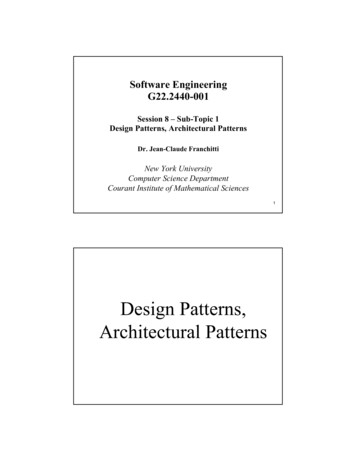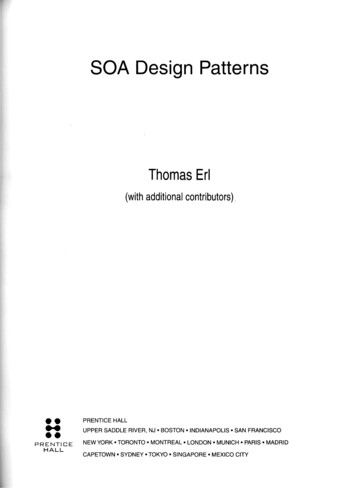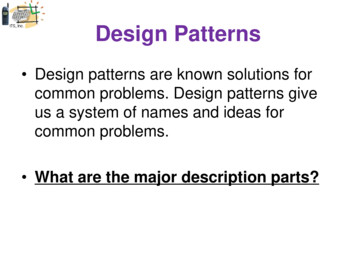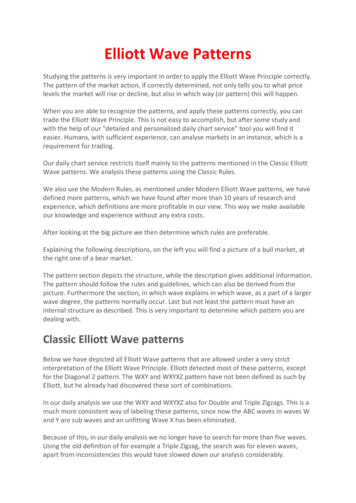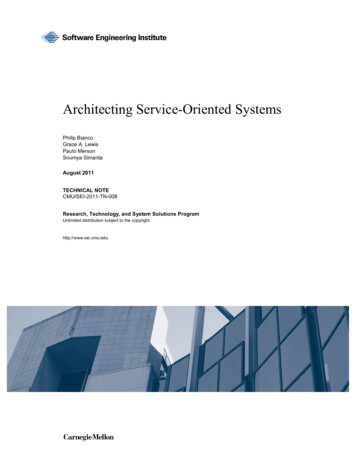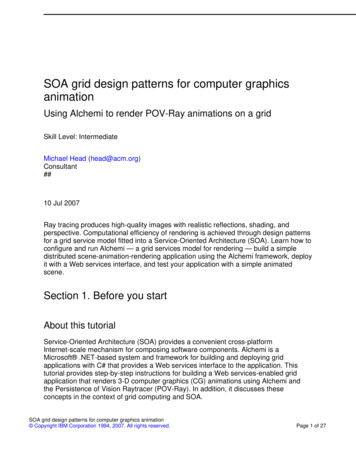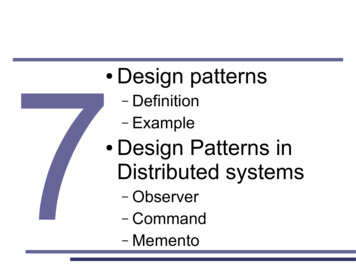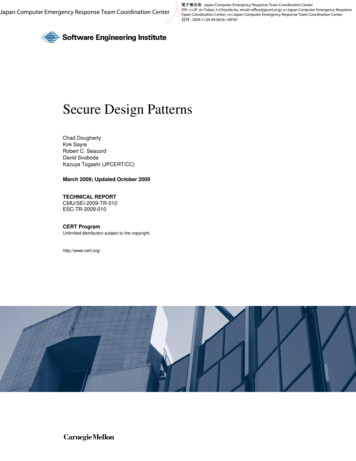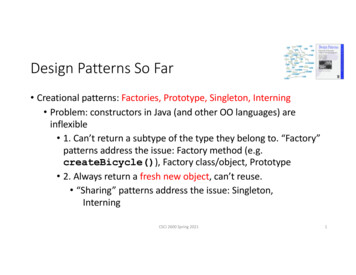
Transcription
Design Patterns So Far Creational patterns: Factories, Prototype, Singleton, Interning Problem: constructors in Java (and other OO languages) areinflexible 1. Can’t return a subtype of the type they belong to. “Factory”patterns address the issue: Factory method (e.g.createBicycle()), Factory class/object, Prototype 2. Always return a fresh new object, can’t reuse. “Sharing” patterns address the issue: Singleton,InterningCSCI 2600 Spring 20211
Design Patterns FlyWeight Many objects are similar Objects have many common components Wrappers: Adapter, Decorator, Proxy Structural patterns: when we want to change interface orfunctionality of an existing class, or restrict access to an object Composite A structural pattern: expresses whole-part structures, givesuniform interface to client Patterns for traversal of composites: Interpreter,Procedural and VisitorCSCI 2600 Spring 20212
Flyweight Pattern Good when many objects are mostly the same Interning works only if objects fall into groups and objects in each group arecompletely the same and immutable If there is an intrinsic state that is the same across all objects Intern it If there is an extrinsic state that is different for different objects Extrinsic - not part of the essential nature of someone or something; coming or operatingfrom outside. Represent it explicitlyCSCI 2600 Spring 20213
Flyweight Pattern The flyweight pattern is primarily used to reduce the number ofobjects created decrease memory footprintincrease performancedecrease object countcreates new object when no matching object is found.Flyweight pattern often involves a Factory or compositionCSCI 2600 Spring 20214
Flyweight ExampleWe will demonstrate this pattern by drawing 20 circlesat different locations but we will create only 5 objects.Only 5 colors are available, so the color property is usedto check already existing Circle objects.Similar to memoization.https://www.tutorialspoint.com/design pattern/flyweight pattern.htmCSCI 2600 Spring 20215
public interface Shape {void draw();}public class ShapeFactory {private static final HashMap String, Shape circleMap new HashMap String, Shape ();public class Circle implements Shape {private String color; // intrinsicprivate int x;private int y;private int radius;public static Shape getCircle(String color) {Circle circle (Circle)circleMap.get(color);public Circle(String color){this.color color;}}@Override}public void draw() {System.out.println("Circle: Draw() [Color : " color ", x : " x ", y :" y ", radius :" radius);} }if(circle null) {circle new Circle(color);circleMap.put(color, circle);System.out.println("Creating circle of color : " color);}return circle;CSCI 2600 Spring 20216
public class FlyweightPatternDemo {private static final String colors[] { "Red", "Green", "Blue", "White", "Black" };public static void main(String[] args) {for(int i 0; i 20; i) {Circle circle ;circle.setRadius(100);circle.draw();}}}private static String getRandomColor() {return e static int getRandomX() {return (int)(Math.random()*100 );}private static int getRandomY() {return (int)(Math.random()*100);}CSCI 2600 Spring 20217
Creating circle of color : BlackCircle: Draw() [Color : Black, x : 36, y :71, radius :100Creating circle of color : GreenCircle: Draw() [Color : Green, x : 27, y :27, radius :100Creating circle of color : WhiteCircle: Draw() [Color : White, x : 64, y :10, radius :100Creating circle of color : RedCircle: Draw() [Color : Red, x : 15, y :44, radius :100Circle: Draw() [Color : Green, x : 19, y :10, radius :100Circle: Draw() [Color : Green, x : 94, y :32, radius :100Circle: Draw() [Color : White, x : 69, y :98, radius :100Creating circle of color : BlueCircle: Draw() [Color : Blue, x : 13, y :4, radius :100Circle: Draw() [Color : Green, x : 21, y :21, radius :100Circle: Draw() [Color : Blue, x : 55, y :86, radius :100Circle: Draw() [Color : White, x : 90, y :70, radius :100Circle: Draw() [Color : Green, x : 78, y :3, radius :100Circle: Draw() [Color : Green, x : 64, y :89, radius :100Circle: Draw() [Color : Blue, x : 3, y :91, radius :100Circle: Draw() [Color : Blue, x : 62, y :82, radius :100Circle: Draw() [Color : Green, x : 97, y :61, radius :100Circle: Draw() [Color : Green, x : 86, y :12, radius :100Circle: Draw() [Color : Green, x : 38, y :93, radius :100Circle: Draw() [Color : Red, x : 76, y :82, radius :100Circle: Draw() [Color : Blue, x : 95, y :82, radius :100CSCI 2600 Spring 20218
Flyweight and Interning The previous example looks a lot like interning It is. Only a single instance of a circle with a color is created Flyweight often uses interning. To store the common parts of object In example, color is common part Other parts are set by getCircle()CSCI 2600 Spring 2021
Another Flyweight Example Paint Brush application where client can use brushes on three types –THICK, THIN and MEDIUM. All the thick (thin or medium) brushes will draw the content in a similarfashion only the content color will be different. Brush color is the extrinsic attribute which will be supplied by client Everything else will remain the same for the Pen. Client creates three THIN pens 2 YELLOW, 1 BLUE Runtime there is only one pen object of each color type Looks a lot like interning See FlyWeightDemo3.javaCSCI 2600 Spring 2021
Example: bicycle spokes 32 to 36 spokes per wheel Only 3 varieties per bike model In a bike race, hundreds of spoke varieties Thousands of instancesclass Wheel {FullSpoke[] spokes;.}class FullSpoke {int length;int diameter;bool tapered;Metal material;float weight;float threading;bool crimped;int location; // rim and hub holes this is installed inCSCI 2600 Spring 202112
Alternatives to FullSpokeInternIntrinsicSpokeclass IntrinsicSpoke {int length;int diameter;boolean tapered;Metal material;float weight;float threading;boolean crimped;}Doesn’t savespace.Same asFullSpokeclass InstalledSpokeFull extends IntrinsicSpoke {int location;}class InstalledSpokeWrapper {IntrinsicSpoke s; // refer to interned objectint location;}CSCI 2600 Spring 2021Composition Saves spacebecause ofinterning13
Align (true) a Wheelclass FullSpoke {// Tension the spoke by turning the nipple the// specified number of turns.void tighten(int turns) {. location . // location is a field}}What isclass Wheel {value ofFullSpoke[] spokes;locationvoid align() {inwhile ( wheel is misaligned) {spokes[i]// tension the ith spoke. spokes[i].tighten(numturns) .}}}CSCI 2600 Spring 202114
Flyweight code to true (align) a wheelclass IntrinsicSpoke {void tighten(int turns, int location) {. location . // location is a parameter}}class Wheel {IntrinsicSpoke[] spokes;void align() {while (wheel is misaligned) {// tension the ith spoke. spokes[i].tighten(numturns, i) . // pass the location to tighten()}}}CSCI 2600 Spring 202115
Flyweight Pattern What if FullSpoke contains a wheel field pointing at the Wheel containing it? Wheel methods pass this to the methods that use the wheel field. What if Fullspoke contains a boolean indication of a broken spoke Add an array of booleans parallel to spokes Flyweight used when there are very few mutable (extrinsic) fields Complicates code Use when profiling has determined that space is a serious problemCSCI 2600 Spring 202116
When to use the Flyweight PatternThousands of new instantiation occurrences of a memory intensive heavy objectThe objects created via the heavy object have very similar featuresin every instantiation occurrenceThe object pool contains many similar objects and two objects fromthe pool don’t differ significantlyThe object creation consumes high memory usageObjects have the shareable ability
Wrappers A wrapper uses composition/delegation A wrapper is a thin layer over an encapsulated class Modify the interface GraphWrapper Extend behavior of encapsulated class Restrict access to encapsulated object The encapsulated object (delegate) does most work Wrapper is not a GoF pattern Similar to Adapter and Façade GoF patternsCSCI 2600 Spring 202118
Structural ntDecoratorDifferentSame/DifferentProxySameSame
Adapter Pattern The purpose of the Adapter is: change an interface, without changing the functionality of the encapsulated class Allows reuse of functionality Protects client from modification of encapsulated class Reasons Rename methods Convert units Reformat output Example Angles passed in radians instead of degreesCSCI 2600 Spring 202120
Adapter Pattern Bridge between two incompatible interfaces Single class which is responsible to join functionalities of independentor incompatible interfaces. Example: SD card reader which acts as an adapter between memory card anda laptop.CSCI 2600 Spring 202121
Adapter Example Mapping a user-friendly common interface to legacy-specific peculiarinterfaces. Line and Rectangle both have draw methods Different classes, not subtypes of a common supertype Adapter methods are subtypes of Shape Provide a draw methods Client codes against Shape Client can use common methods See AdapterDemo.javaCSCI 2600 Spring 2021
Adapter Examplehttps://www.tutorialspoint.com/design pattern/adapter pattern.htmCSCI 2600 Spring 202124
public interface MediaPlayer {public void play(String audioType, String fileName);}public interface AdvancedMediaPlayer {public void playVlc(String fileName);public void playMp4(String fileName);}public class VlcPlayer implements AdvancedMediaPlayer{@Overridepublic void playVlc(String fileName) {System.out.println("Playing aac file. Name: " fileName);} @Overridepublic void playMp4(String fileName) {//do nothing}}public class Mp4Player implements AdvancedMediaPlayer{@Overridepublic void playVlc(String fileName) {//do nothing}@Overridepublic void playMp4(String fileName) {System.out.println("Playing mp4 file. Name: " fileName);}CSCI 2600 Spring} 202125
CSCI 2600 Spring 202126
public class AdapterPatternDemo {public static void main(String[] args) {AudioPlayer audioPlayer new AudioPlayer();public class AudioPlayer implements MediaPlayer {MediaAdapter mediaAdapter;@Overridepublic void play(String audioType, String fileName) {//inbuilt support to play mp3 music out.println("Playing mp3 file. Name: " fileName);}}}audioPlayer.play("mp3", "beyond the horizon.mp3");audioPlayer.play("mp4", "alone.mp4");audioPlayer.play("vlc", "far far away.vlc");audioPlayer.play("avi", "mind me.avi");//mediaAdapter is providing support to play other file formatselse if(audioType.equalsIgnoreCase("vlc") audioType.equalsIgnoreCase("mp4")){mediaAdapter new e, fileName);}}}else{System.out.println("Invalid media. " audioType " format not supported");}CSCI 2600 Spring 202127
Adapter Pattern Motivation: reuse a class with an interface different than the anipulator()return text.GetExtent();CSCI 2600 Spring 2021return new TextManipulator;28
Adapter Pattern We would like to use TextView, which contains a completedimplementation. However, the client Editor expects the Shape interface. If we changed Editor to work with TextView, then we’d have to modifyhundreds of places in Editor where Editor uses the Shape interface: e.g., we have to change all calls to BoundedBox() to calls to GetExtent(). The Adapter pattern allows us to change Editor minimally and still use theimplementation of TextView. We’ll create an Adapter class Text, which encloses TextView and redirectsthe calls to BoundingBox() to text.GetExtent(); Editor refers to a Text object, so it keeps calling BoundingBox(), which usesTextViewCSCI 2600 Spring 2021
GoF Adapters GoF (Gang of Four) describes two major kinds of adapters: Class adapters Use multiple inheritance to adapt one interface to another. Java doesn't allow multiple inheritance. We need to use interfaces. Object adapters Depend on the object compositions.CSCI 2600 Spring 2021
Adapter Example: Scaling Rectanglesinterface Rectangle {void scale(int factor); //grow or shrink by factorvoid setWidth();float getWidth();float area(); }class Client {void clientMethod(Rectangle r) { r.scale(2);}}class NonScalableRectangle {Can we usevoid setWidth(); NonScalableRectangle// no scale method!in Client instead?}CSCI 2600 Spring 202131
Class Adapter Class adapter adapts via subclassingclass ScalableRectangle1extends NonScalableRectangleimplements Rectangle {void scale(int factor) eight());}}CSCI 2600 Spring 202132
Object Adapter Object adapter adapts via delegation: it forwards work to delegateclass ScalableRectangle2 implements Rectangle {NonScalableRectangle r; // delegateScalableRectangle2(NonScalableRectangle r) {this.r r;}void scale(int factor) {r.setWidth(factor * r.getWidth());r.setHeight(factor * r.getHeight());}float getWidth() { return r.getWidth(); } }CSCI 2600 Spring 202133
Subclassing Versus Delegation Subclassing Automatically gives access to all methods in the superclass More efficient Delegation Permits removal of methods Multiple objects can be composed More flexible Some wrappers have qualities of adapter, decorator, and proxy Differences are subtleCSCI 2600 Spring 202134
Another Example A Point-of-Sale system needs to support services from different third-partyvendors: Tax calculator service from different vendors Credit authorization service from different vendors Inventory systems from different vendors Accounting systems from different vendors Each vendor service has its own API, which can’t be changed What design pattern helps solve this problem?CSCI 2600 Spring 202136
The Solution: Object AdapterPOS System interface ITaxCalculatorAdaptergetTaxes(Sale) : List of rgetTaxes(Sale) : List of TaxLineItemsgetTaxes(Sale) : List of TaxLineItems interface IAccountingAdapter interface ayment,TerminalID, MerchantID)CSCI 2600 Spring 202137
Object Adapter TaxMasterAdapter adapts the TaxMaster interface to the expectedinterface. Same for the GoodAsGoldTaxProAdapter. The client, POS System uses the interface defined inITaxCalculatorAdapter. If the POS System needs to change from one vendor’s system toanother, the changes to the POS System client will be minimal tonone!CSCI 2600 Spring 2021
Exercise Who creates the appropriate adapter object? Is it a good idea to let some domain object from the Point-of-Sale system (e.g.,Register, Sale) create the adapters? That would assign responsibility beyond domain object’s logic. We would like to keepdomain classes focused, so, this is not a good idea Violates principle of single responsibility for a class How to determine what type of adapter object to create? We expectadapters to change. What design patterns solve this problem?CSCI 2600 Spring 202139
The Solution: FactoryServiceFactoryaccountingAdapter : IAccountingAdapterinventoryAdapter : IInventoryAdaptertaxCalculatorAdapter : ITaxCalculatorAdaptergetAccountingAdapter() : IAccountingAdaptergetInventoryAdapter () : IInventoryAdaptergetTaxCalculatorAdapter () : ITaxCalculatorAdapterCSCI 2600 Spring 202140
Using the Factorypublic ITaxCalculatorAdaptergetTaxCalculatorAdapter() {if (taxCalculatorAdapter null) {String className taxCalculatorAdapter wInstance();}return taxCalculatorAdapter;} What design pattern(s) do you see here?Java reflection: creates a brandnew object from String className!CSCI 2600 Spring 202141
Exercise Who creates the ServiceFactory? How is it accessed? We need a single instance of the ServiceFactory class What pattern solves these problems?CSCI 2600 Spring 202142
Special UMLnotation.The Solution: SingletonServiceFactory1- instance: ServiceFactory- accountingAdapter : IAccountingAdapter- inventoryAdapter : IInventoryAdapter- taxCalculatorAdapter : ITaxCalculatorAdapter getInstance() : ServiceFactory getAccountingAdapter() : IAccountingAdapter getInventoryAdapter() : IInventoryAdapter getTaxCalculatorAdapter() : ITaxCalculatorAdapterIn UML, - means private, means public. All (shown) fields inServiceFactory are private and all methods are public.underline means static. instance and getInstance arestatic. Single instance of ServiceFactory ensures singleCSCI 2600 Spring 2021instance of adapter objects.43
Composite Pattern Client treats a composite object (a collection of objects) the same as asimple object (an atomic unit) Good for part-whole relationships Can represent arbitrarily complex objects Composite pattern composes objects in terms of a tree structure torepresent the part as well as the whole hierarchy. This pattern creates a class that contains a group of objects. The class provides ways to modify its group of objects.CSCI 2600 Spring 202144
OrganizationChartCSCI 2600 Spring 202145
public interface Employee {}public void add(Employee employee);public void remove(Employee employee);public Employee getChild(int i);public String getName();public double getSalary();public void print();public class Manager implements Employee{private String name;private double salary;public Manager(String name, double salary){this.name name;this.salary salary;}List Employee employees new ArrayList Employee ();public void add(Employee employee) {employees.add(employee);}public Employee getChild(int i) {return employees.get(i);} // implements print – traverses employees}CSCI 2600 Spring 202146
public class Developer implements Employee{}public static void main(String[] args) {Employee emp1 new Developer("John", 10000);private String name;Employee emp2 new Developer("David", 15000);private double salary;Employee manager1 new Manager("Daniel",25000);manager1.add(emp1);public Developer(String name, double salary){manager1.add(emp2);this.name name;Employee emp3 new Developer("Michael", 20000);this.salary salary;Manager generalManager new Manager("Mark", 50000);}generalManager.add(emp3);public void add(Employee employee) {generalManager.add(manager1);//this is leaf node so this method is not applicable to this class. generalManager.print();}}}public Employee getChild(int i) {//this is leaf node so this method is not applicable to this class.return null;} CSCI 2600 Spring 202147
Composite Example Compose objects into tree structures to represent part-whole hierarchies. Composite lets clients treat individual objects and compositions of objectsuniformly. Example Every sentence is composed of words which are in turn composed of characters. Each of these objects is printable and they can have something printed before orafter them Sentence always ends with full stop Word always has space before it See CompositeDemo.javaCSCI 2600 Spring 2021
Example: Bicycle Bicycle Wheel Skewer LeverBodyCamRodAcorn nut Hub Spokes Frame CSCI 2600 Spring 202150
Example: Methods on Componentsabstract class BicycleComponent { Skewer is an atomic unitfloat cost();}class Skewer extends BicycleComponent {float price;float cost() { return price; }}class Wheel extends BicycleComponent {float assemblyCost;Skewer skewer;Wheel is a collection of objectsHub hub; float cost() { return assemblyCost skewer.cost() hub.cost() }}CSCI 2600 Spring 202151
Even Betterabstract class BicycleComponent { float cost();}class Skewer extends BicycleComponent {float price;float cost() { return price; }}class Wheel extends BicycleComponent {The skewer and hub arefloat assemblyCost;BicycleCompoenents, so we canBicycleComponent skewer;BicycleComponent hub;use BicycleComponent! float cost() { return assemblyCost skewer.cost() hub.cost() }}CSCI 2600 Spring 202152
Another Example: Boolean Expressions A Boolean expression can be Variable (e.g., x) Boolean constant: true, false Or expression (e.g., x or true) And expression (e.g., (x or true) and y) Not expression (e.g., not x, not (x or y)) And, Or, Not: collections of expressions Variable and Constant: atomic units Maybe we should intern the Boolean constants? See BooleanDemo.javaCSCI 2600 Spring 202153
Interpreter PatternSee BooleanDemo.java
Using Composite to Represent BooleanExpressionsabstract class BooleanExp {boolean eval(Context c);}class Constant extends BooleanExp {private boolean const;Constant(boolean const) { this.const const; }boolean eval(Context c) { return const; }}class VarExp extends BooleanExp {String varname;VarExp(String var) { varname var; }boolean eval(Context c) {return c.lookup(varname);}}CSCI 2600 Spring 202155
Using Composite to Represent BooleanExpressionsclass AndExp extends BooleanExp {private BooleanExp leftExp;private BooleanExp rightExp;AndExp(BooleanExp left, BooleanExp right) {leftExp left;rightExp right;}boolean eval(Context c) {return leftExp.eval(c) && rightExp.eval(c);}}// analogous definitions for OrExp and NotExpCSCI 2600 Spring 202156
Composite Pattern: Class diagram1BooleanExpClient2 2 ConstantVarExpNotExp1Atomic UnitsCSCI 2600 Spring 2021OrExpAndExp11CompositeObjects57
Object Structure Expression (x or true) and ynew AndExp(new OrExp(new VarExp(“x”),new Constant(true)AndExp:(x or true) and yleftExprightExp),new VarExp(“y”))OrExp: x or trueleftExpVarExp: xCSCI 2600 Spring 2021VarExp: yrightExpConstant: true58
Exercise: Object Structure Draw the object structure (a tree!) for expression (x and true)and (y or z)CSCI 2600 Spring 202159
(x and true) and (y or z)new AndExp(new AndExp(new VarExp(“x”) new Constant(true)), new OrExp(new VarExp(“y”), new VarExp(“z”)))AndExp: xand true and(y or z)AndExp: xand trueVarExp: xOrExp: y or zConstant:trueVarExp: yCSCI 2600 Spring 2021VarExp: z60
General Structure of eration()operation()childrenCSCI 2600 Spring 202161
Structure of Composite Component Typically declared as an interface. Implements default behavior for the interface common to all classes as appropriate. Declares an interface for accessing and managing its child components. Leaf Represents leaf objects. A leaf has no children. Defines behavior for primitive objects in the composition. Composite Defines behavior for components having children. Stores child components. Implements child related operations in the component interface. Client Manipulates objects in the composition through the component interface.CSCI 2600 Spring 2021
Add Operations to Manage hild(int)CSCI 2600 Spring 2021children63
Decorators A GoF pattern Adapter is a wrapper Composite is not Decorators can add functionality without changing the interface When to use Add to existing method to do something in addition while preserving theinterface and spec Similar to subclassing Not all subclassing is decorationCSCI 2600 Spring 202164
Decorators The decorator pattern allows a user to add new functionality to anexisting object without altering its structure. This pattern creates a decorator class which wraps the original classand provides additional functionality keeping class method’ssignatures intact.CSCI 2600 Spring 202165
https://xkcd.com/149/
Decorator Example Sandwich class We can have a basic sandwich – bread, filling Might want to add cheese, tomato, lettuce, or other additions decorations We could make a subclass for each combination of additions Each combo has a different price Effective if we have a small number of combinations Decorator pattern allows extension of the functionality of Sandwich atruntime, based upon customer's request We can decorate a sandwich by adding ingredients and charging additional costCSCI 2600 Spring 2021
See SandwichDemo.java
Decorators The decorator must be of the same type of object, which they aredecorating. This can be achieved either by implementing the interface of the object or byextending an abstract class Decorator is usually based on Composition This is achieved by creating a constructor of the decorator class which accepts a basetype of original object. In the example the constructor of CheeseDecorator accepts a Sandwich object. The Decorator pattern is an example of Open/Closed design principle We don't have to change Sandwich to add cheese. The Decorator pattern affects objects at runtimeCSCI 2600 Spring 2021
Structure of DecoratorMotivation: add small chunks of functionality without changing the interface
Exampleabstract class Component { void draw(); }class TextView extends Component {public void draw() {// Draw the TextView}}abstract class Decorator extends Component {private Component component;public Decorator(Component c) {this.component c;}public void draw() {component.draw(); // additional functionality}CSCI 2600 Spring 2021}71
Example: Bordered WindowsAdds a border to the text viewclass BorderDecorator extends Decorator {public BorderDecorator(Component c,int borderwidth) {super(c);Calls Decorator.draw which redirects work to the enclosed component}private void drawBorder() { }public void draw() {super.draw();drawBorder();}Adds a scroll bar to the text view}class ScrollDecorator extends Decorator { }CSCI 2600 Spring 202172
Examplepublic class Client {public static void main(String[] args) {TextView textView new TextView();Component decoratedComponent new BorderDecorator(new ScrollDecorator(textView),1);} decoratedComponent.draw(); }CSCI 2600 Spring 202173
Bordered Windows: Another Versioninterface Window {// rectangle bounding the windowRectangle bounds();// draw this on the specified screenvoid draw(Screen s);.}class WindowImpl implements Window {.}CSCI 2600 Spring 202174
Bordered Windows: Delegation// subclassingclass BorderedWindow1 extends WindowImpl {void draw(Screen s) {super.draw(s);bounds().draw(s);}}Delegation permits multipleborders on a window, or a windowthat is both bordered and shaded(or either one of those)// Via delegation:class BorderedWindow2 implements Window {Window innerWindow;BorderedWindow2(Window innerWindow) {this.innerWindow innerWindow;}void draw(Screen s) }}CSCI 2600 Spring 202175
Java I/O PackageInputStream: byte input am#byte[] bufPipedInputStreamCheckedInputStream FilterInputStreaminDataInputStream FilterInputStream is a Decorator. Enables the “chaining” of streams Each FilterInputStream redirects input action to the enclosed InputStreamCSCI 2600 Spring 202176
Readers: character input ilterReaderClass FilterReader extends Reader {inPushbackReaderReader in;int read() {return in.read();} }CSCI 2600 Spring 202177
Another Decorator Examplepublic class UppercaseConvertor extendsFilterReader {public UppercaseConvertor(Reader in) {super(in);}public int read() throws IOException {int c super.read();return ( c -1 ? c :Character.toUpperCase((char)c));}}We also have LowercaseConverter extendsFilterReader, which (surprise!) converts to lowercaseCSCI 2600 Spring 202178
Another Decorator Examplepublic static void main(String[] args) {Reader f new UppercaseConverter(new LowercaseConvertor(new StringReader(args[0])));int c;while ((c f.read()) ! }What is the object structure of f?What does this code do?CSCI 2600 Spring 202179
Aside: Convert Characters the functional waypublic static List String convertToUpperCase8(List String inList) {return inList.stream() // Convert collection to Stream.map(String::toUpperCase) // Convert each element to upper case.collect(toList()); // Collect results to a new list
Proxy Pattern Same interface and functionality as the enclosed class Control access to enclosed object Communication: manage network details when using a remoteobject Locking: serialize access by multiple clients Security: permit access only if proper credentials Creation: object might not yet exist (creation is expensive).Hide latency when creating object. Avoid work if object neverused Similar to singleton/interningCSCI 2600 Spring 202181
Recap: Simple Proxy Examplehttps://www.tutorialspoint.com/design pattern/proxy pattern.htmCSCI 2600 Spring 202182
public interface Image {void display();}public class ProxyImage implements Image{// delegationprivate RealImage realImage;private String fileName;public class RealImage implements Image {private String fileName;public RealImage(String fileName){this.fileName fileName;loadFromDisk(fileName);}public ProxyImage(String fileName){this.fileName fileName;}@Overridepublic void display() {System.out.println("Displaying " fileName);}}private void loadFromDisk(String fileName){System.out.println("Loading " fileName);}}CSCI 2600 Spring 2021@Overridepublic void display() {if(realImage null){realImage new RealImage(fileName);}realImage.display();}83
public class ProxyPatternDemo {public static void main(String[] args) {Image image new ProxyImage("test 100mb.jpg");//image will be loaded from ge will not be loaded from diskimage.display();CSCI 2600 Sprin
Design Patterns So Far Creational patterns: Factories, Prototype, Singleton, Interning Problem: constructors in Java (and other OO languages) are inflexible 1. Can’t return a subtype of the type they belong to. “Factory” patterns address the issue: Factory method (e
